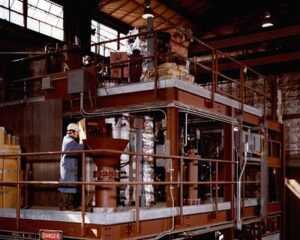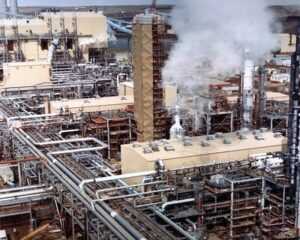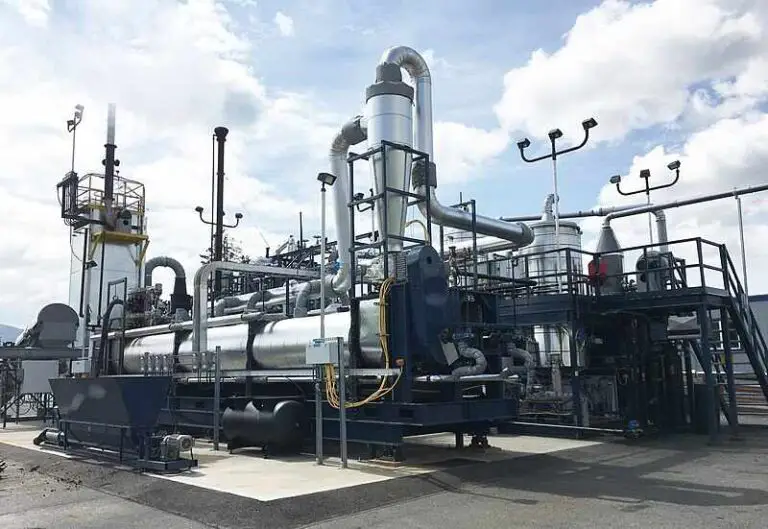7 Gasification Products and their Characteristics Explained
Gasification products include; carbon monoxide (CO), carbon dioxide (CO2), methane (CH4), nitrogen (N2), hydrogen (H2), steam (H2O), and residue.
They are collectively referred to as ‘producer gas’ or ‘syngas’; which is a flammable gas (or biofuel) with lower energy density than petroleum, but which can be used for domestic heating, transport and electricity generation, among other purposes.
This article discusses gasification products and their characteristics, as follows;
1). Carbon Monoxide (CO) (as one of the Gasification Products)
Carbon monoxide (CO) is an odorless, colorless and highly-flammable gas [6].
In gasification, carbon monoxide is specifically formed when biomass feedstock undergoes thermal degradation in the absence of oxygen. This may be alternatively called ‘incomplete combustion’, and is a reduction-based thermo-chemical process.
In cases where reduction is included in the gasification process, carbon monoxide can be formed as a result of the reduction of carbon dioxide (CO2), which is also produced from gasification.
The formation of carbon monoxide is one of the disadvantages of gasification due to its high level of toxicity. When inhaled in significant amounts, carbon monoxide can cause systemic poisoning and death [8].
2). Carbon Dioxide (CO2)
In the gasification process, carbon dioxide is produced when biomass undergoes thermal degradation in the presence of significant amounts of oxygen.
It occurs as a colorless and odorless gas, and is described in some studies as having a faint pungent odor and a sour taste [4]. Unlike carbon monoxide, the gas is non-toxic, and is not flammable.
Naturally, carbon dioxide is produced through biodegradation, as part of processes involved in the circulation of bioenergy in the ecosystem, across the various trophic levels of the energy pyramid.
As a greenhouse gas, carbon dioxide contributes to environmental degradation in the form of global warming and climate change.
3). Methane (CH4) (as one of the Gasification Products)
Methane is one of the most valuable products of gasification. This is because of its relevance as a fuel.
It occurs as a colorless, flammable and colorless gas, which is produced from thermal decomposition of organic materials. In nature, methane can also be produced from biodegradation.
The thermo-chemical reaction which yields methane usually includes hydrogen and carbon monoxide as reactants. In some cases, a catalyst can be used to optimize methane production during gasification [5].
Being a greenhouse gas, methane contributes to global warming, and is capable of trapping more heat than carbon dioxide.
The formation of methane also poses safety risks in gasification plants, due to its flammability.

4). Nitrogen (N2)
Gasification leads to the formation of nitrogen because it is a chemical component of all forms of biomass and coal [3].
Nitrogen occurs as a tasteless, odorless and colorless gas, which constitutes up to 78% of atmospheric air [1].
In gasification, nitrogen is often produced in the form of compounds like hydrogen cyanide, ammonia or aromatic hydrocarbon. It may be isolated from these by reduction, or other forms of treatment.
Under some conditions, such as steam gasification and char gasification, nitrogen is produced in very small amounts.
5). Hydrogen (H2) (as one of the Gasification Products)
Like nitrogen, hydrogen is produced from gasification due to its presence in all forms of organic feedstock.
It is the lightest and most abundant known element in the universe, and is flammable, acting as a fuel in the presence of oxygen.
Hydrogen is produced from gasification usually in the ratio 2:1, with respect to CO2. It is often a product of the reduction of steam (H2O).
As a fuel, it can be liquefied under cryogenic conditions to produce liquid hydrogen, which can be used in fuel cells for energy production.
6). Steam (H2O)
Steam is an important component of the gasification process, which is produced from biomass feedstock by the oxidation of hydrogen.
Aside being a gasification product, steam is also used as a gasification agent.
Where it constitutes most of the heat energy source in a gasifier, the process is referred to as ‘steam gasification’, and is known to yield less nitrogen and large amounts of hydrogen [7].

7). Residue (as one of the Gasification Products)
Residue in gasification includes all remnants of the process of thermal conversion of feedstock.
It could be referred to as ash, char, or slag.
The residue can be further subjected to gasification (char gasification) to yield more products [2].
Conclusion
Gasification products are;
1. Carbon Monoxide (CO)
2. Carbon Dioxide (CO2)
3. Methane (CH4)
4. Nitrogen (N2)
5. Hydrogen (H2)
6. Steam (H2O)
7. Residue
References
1). Çalışkan, F. T.; Aksay, E. (2012). “Asphyxia Due to Accidental Nitrogen Gas Inhalation: A Case Report.” Journal of Emergency Medicine 19(1):46-48. Available at: https://doi.org/10.1177/102490791201900108. (Accessed 8 October 2022).
2). Jeguirim, M.; Tamosiunas, A. (2019). “Char gasification.” Available at: https://www.researchgate.net/publication/346626077_Char_gasification. (Accessed 8 October 2022).
3). Jong, W. (2005). “Nitrogen compounds in pressurised fluidised bed gasification of biomass and fossil fuels.” Available at: https://repository.tudelft.nl/islandora/object/uuid%3A10922fbb-6891-4ddd-9971-d3c8e3d22e05. (Accessed 8 October 2022).
4). Kaliyan, N.; Morey, R. V.; Wilcke, R. V.; Alagusundaram, K.; Gayathri, P. (2007). “Applications of Carbon Dioxide in Food and Processing Industries: Current Status and Future Thrusts.” Available at: https://doi.org/10.13031/2013.23553. (Accessed 8 October 2022).
5). Li, W. W.; Yu, Z.; Guan, G. (2021). “Catalytic coal gasification for methane production: A Review.” Carbon Resources Conversion 4:89-99. Available at: https://doi.org/10.1016/j.crcon.2021.02.001. (Accessed 8 October 2022).
6). Ogunkunle, O.; Ahmed, N. A. (2021). “Overview of Biodiesel Combustion in Mitigating the Adverse Impacts of Engine Emissions on the Sustainable Human–Environment Scenario.” Sustainability 13(10):5465. Available at: https://doi.org/10.3390/su13105465. (Accessed 8 October 2022).
7). Parthasarathy, P.; Narayanan, S. (2014). “Hydrogen production from steam gasification of biomass: Influence of process parameters on hydrogen yield – A review.” Renewable Energy 66:570-579. Available at: https://doi.org/10.1016/j.renene.2013.12.025. (Accessed 8 October 2022).
8). Rose, J. J.; Wang, L.; Xu, Q.; Mctiernan, C.; Shiva, S.; Tejero, J.; Gladwin, M. T. (2016). “Carbon Monoxide Poisoning: Pathogenesis, Management and Future Directions of Therapy.” American Journal of Respiratory and Critical Care Medicine 195(5). Available at: https://doi.org/10.1164/rccm.201606-1275CI. (Accessed 8 October 2022).




